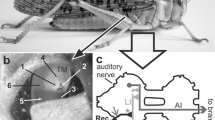Summary
We show the variations in the spike activity of both auditory receptors inSpodoptera frugiperda, Mocis latipes, Ascalapha odorata (Noctuidae),Maenas jussiae andEmpyreuma pugione (Arctiidae) immediately after 45 ms and 5 s acoustic stimuli at different intensities. The frequency of the applied stimuli was 34 kHz forE. pugione and 20 kHz for the other species. The electrical activity of the auditory receptors was recorded at the tympanic nerve with a stainless steel hook electrode. When the 45 ms pulses cease there is an afterdischarge from both auditory receptors in all the species. The number of spikes in the afterdischarge activity of both receptor cells (A1 and A2) shows a linear relation with stimulus intensity (Table 1). This number increases monotonically with increments in stimulus intensity, except for the A1 cell activity inE. pugione, which decreases at intensities higher than 55 dB (Fig. 1). There are significant species-specific differences in the slope values of the number of spikes in the afterdischarge of both auditory receptors. After a 5 s stimulusM. latipes andM. jussiae show a rapid recovery of the standard spontaneous A1-cell discharge level. Poststimulus A1-cell spike activity inS. frugiperda shows a silent period, the duration of which increases with stimulus intensity (Fig. 3).E. pugione andA. odorata show such a silent period after low and moderately intense stimuli, but at high intensities the post-stimulus activity exceeds the pre-stimulus spontaneous discharge (Fig. 3). We demonstrate statistically that these variations cannot be explained by the random fluctuations of the standard spontaneous discharge. They are thus considered a silent and a rebound period respectively (Fig. 5). The presence and duration of either type of period seem to depend on the magnitude of the response to the acoustic stimulus. They thus seem related to the adaptation rate and the previously suggested existence of peripheral inhibitory interaction between the auditory receptors.
Similar content being viewed by others
References
Adams WB (1971) Intensity characteristics of the noctuid acoustic receptor. J Gen Physio) 58:562–579
Coro F (1979) Organizatión morfo-funcional de los receptores auditivos enEmpyreuma pugione (Lepidoptera). PhD thesis La Habana-Moscow
Coro F, Pérez M (1983) Peripheral interaction in the tympanic organ of a moth. Naturwissenschaften 70:99–100
Coro F, Pérez M (1984) Intensity coding by auditory receptors inEmpyreuma pugione (Lepidoptera, Ctenuchidae). J Comp Physiol A 154:287–295
Coro F, Pérez M, López JR (1984) Emisión de señales acústicas enEmpyreuma pugione (Lepidoptera, Ctenuchidae). Cien Biol 10:5–18
Eggers F (1916) Notes supplementaires sur l'organe tympanal thoracal des Noctuides et de quelques autres familles de Lepidoptères. Rev Russe d'Entomol 16:249–265
Eggers F (1919) Das thoracale bitympanale Organ einer Gruppe der Lepidoptera Heterocera. Zool Jb (Anat) 41:273–376
Fullard JH (1982) Cephalic influences on a defensive behavior in the dogbane tiger moth,Cycnia tenera. Physiol Entomol 7:157–162
Ghiradella H (1971) Fine structure of the noctuid moth ear. I. The transducer area and connection to the tympanic membrane inFeltia subgothica (Haworth). J Morphol 134:21–45
Hartline HK, Ratliff F, Miller WH (1961) Inhibitory interaction in the retina and its significance in vision. In: Florey E (ed) Nervous inhibition. Pergamon Press, London, pp 241–284
Haskell PT, Beiton P (1956) Electrical responses in certain lepidopterous tympanic organs. Nature 177:139–140
Kay RE (1969) Acoustic signalling and its possible relationship to assembling and navigation in the moth,Heliothis zea. J Insect Physiol 15:989–1001
Lechtenberg R (1971) Acoustic response of the B cell in noctuid moths. J Insect Physiol 17:2395–2408
Miller LA (1982) The orientation and evasive behavior of insects to bat cries. In: Addink AD, Spronk N (eds) Exogenous and endogenous influences on metabolism and neural control. Vol I. Pergamon Press, London, pp 393–405
Neuweiler G (1983) Echolocation. In: Hoppe W, Lohmann W, Markl H, Ziegler H (eds) Biophysics. Springer, Berlin Heidelberg New York, pp 683–697
Neuweiler G (1984) Foraging, echolocation and audition in bats. Naturwissenschaften 71:446–455
Pérez M, Coro F (1983) Activitdad eléctrica espontánea del órgano timpánico en varias especies de lepidópteros. Cien Biol 9:25–36
Pérez M, Coro F (1984) Physiological characteristics of the tympanic organ in noctuoid moths. I. Responses to brief acoustic pulses. J Comp Physiol A 154:441–447
Pérez M, Coro F (1985) Physiological characteristics of the tympanic organ in noctuoid moths. II. Responses to 45 ms and 5 s acoustic stimuli. J Comp Physiol A 156:689–696
Ratliff F (1961) Inhibitory interaction and the detection and enhancement of contours. In: Rosenblith WA (ed) Sensory communication. Technology Press, Cambridge, pp 325–340
Roeder KD (1964a) Aspects of the noctuid tympanic nerve response having significance in the avoidance of bats. J Insect Physiol 10:529–546
Roeder KD (1964b) Night fighters in a sonic duel. Natural History 73:33–39
Roeder KD (1974a) Responses of the less sensitive acoustic sense cells in the tympanic organs of some noctuid and geometrid moths. J Insect Physiol 20:55–66
Roeder KD (1974b) Acoustic sensory responses and possible bat evasion tactics of certain moths. Can Soc Zool Annu Meeting, Proc Univ New Brunswick, Fredricton, pp 71–78
Roeder KD, Treat AE (1957) Ultrasonic reception by the tympanic organ of noctuid moths. J Exp Zool 134:127–158
Roeder KD, Treat AE (1960) The acoustic detection of bats by moths. Proc XI Intern Entomol Congr, pp 150–158
Schiolten P, Larsen ON, Michelsen A (1981) Mechanical time resolution in some insect ears. I. Impulse responses and time constants. J Comp Physiol 143:289–295
Author information
Authors and Affiliations
Rights and permissions
About this article
Cite this article
Pérez, M., Coro, F. Physiological characteristics of the tympanic organ in noctuoid moths. J. Comp. Physiol. 159, 115–122 (1986). https://doi.org/10.1007/BF00612502
Accepted:
Issue Date:
DOI: https://doi.org/10.1007/BF00612502




